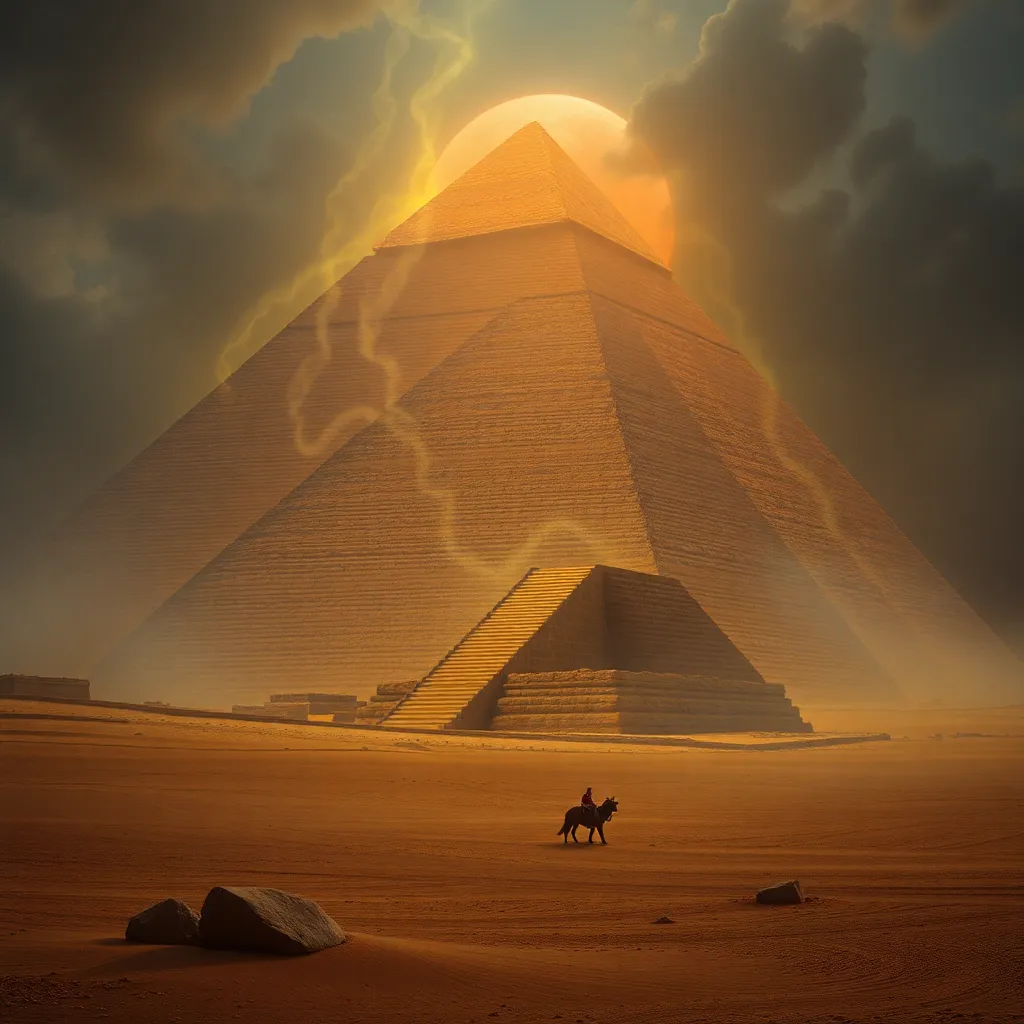The Ghosts of the Great Pyramids: Exploring Egyptian Ghostlore
I. Introduction
Egyptian mythology is a rich tapestry of beliefs, rituals, and narratives that have captivated the imagination of people for centuries. Central to this mythology is the concept of the afterlife, where the dead journey to a realm that transcends the earthly existence. Among the monumental symbols of this belief are the Great Pyramids of Giza, which stand not only as architectural marvels but also as profound embodiments of the ancient Egyptians’ spiritual convictions.
The Great Pyramids hold a significant place in Egyptian culture as tombs for pharaohs, designed to facilitate their passage into the afterlife. The purpose of this article is to delve into the ghost stories and beliefs associated with these magnificent structures, exploring how they reflect the ancient Egyptians’ views on life, death, and the supernatural.
II. Historical Context of Egyptian Beliefs about the Afterlife
The ancient Egyptians had a complex understanding of death and the afterlife. They believed that life continued in a different form after death, and this belief influenced their burial practices, rituals, and monumental constructions like the pyramids.
The pyramids served as monumental tombs for pharaohs, reflecting the Egyptians’ desire to ensure a successful journey into the afterlife. They were constructed with the intention of providing a safe haven for the deceased, filled with goods and treasures that would be needed in the next life.
Historical texts, such as the Pyramid Texts and Coffin Texts, recount tales of spirits and ghosts, providing insights into how the ancient Egyptians perceived the souls of the departed. These texts often included spells and incantations aimed at protecting the deceased and guiding them through the afterlife.
III. Famous Ghost Stories Linked to the Great Pyramids
Throughout history, many ghost stories and supernatural encounters have been associated with the Great Pyramids. These tales often feature the spirits of pharaohs and other important figures from ancient Egyptian society.
A. The Phantom Pharaohs: Ghostly encounters with ancient rulers
Visitors and archaeologists alike have reported encounters with what they believe to be the spirits of ancient pharaohs. These encounters often include:
- Unexplained noises echoing through the chambers
- Sudden drops in temperature
- Flickering lights and shadows moving in the corners of their vision
B. Tales of cursed tombs and their supernatural repercussions
Stories of cursed tombs abound, suggesting that disturbing the resting place of a pharaoh could lead to dire consequences. The most famous of these is the curse of Tutankhamun, which many believe led to the untimely deaths of several individuals associated with the tomb’s discovery.
C. Modern-day sightings and experiences of visitors and archaeologists
Modern visitors to the pyramids have shared eerie experiences that echo the ghostly tales of the past. Some report seeing apparitions or feeling an inexplicable presence while exploring the ancient sites.
IV. The Role of the Pyramid Builders and Their Spirits
The construction of the pyramids was a monumental task, involving thousands of laborers. The beliefs surrounding these workers and their spirits have also contributed to ghostlore.
A. Beliefs about the souls of laborers and their connection to the pyramids
The ancient Egyptians believed that the souls of laborers who died during the construction of the pyramids remained connected to the structures. This belief has given rise to ghost stories that honor these workers.
B. Ghost stories surrounding the construction and death of pyramid builders
Several tales recount the spirits of laborers who haunt the pyramids, often appearing to protect the sites from desecration or to seek recognition for their hard work.
C. Rituals and practices to honor the spirits of the deceased workers
Rituals were performed to honor the spirits of those who died during the construction. Offerings of food and drink were left at the site to appease the spirits and ensure their peace.
V. The Influence of Egyptian Ghostlore on Popular Culture
Egyptian ghost stories have permeated popular culture, influencing literature, film, and tourism.
A. Representation of Egyptian ghosts in literature and films
From classic literature to modern cinema, Egyptian ghosts have been portrayed in various ways, often embodying themes of mystery, revenge, and the supernatural. Films like “The Mummy” and books like “The Egyptian Book of the Dead” explore these themes, captivating audiences worldwide.
B. The impact of ghost stories on tourism and the perception of the pyramids
Ghost stories associated with the pyramids have significantly impacted tourism. Many visitors seek out these tales, hoping to experience the supernatural for themselves, which in turn boosts local economies.
C. Modern adaptations and reinterpretations of ancient tales
Modern adaptations of ancient Egyptian ghost stories often reinterpret the narratives to fit contemporary contexts, blending historical facts with fictional elements.
VI. Ghost Hunting and Paranormal Investigations at the Pyramids
Ghost hunting has emerged as a cultural phenomenon, attracting enthusiasts to locations like the Great Pyramids.
A. Overview of ghost hunting as a cultural phenomenon
Ghost hunting combines elements of history, mythology, and the supernatural, appealing to both skeptics and believers. The pyramids, with their rich history, provide a compelling backdrop for these investigations.
B. Notable paranormal investigations at the Great Pyramids
Various paranormal teams have conducted investigations at the pyramids, employing techniques such as EVP (Electronic Voice Phenomena) sessions and thermal imaging to detect signs of the supernatural.
C. Evidence and experiences reported by ghost hunters and enthusiasts
Many ghost hunters report capturing unexplained phenomena, such as ghostly figures in photographs or strange sounds during investigations, adding to the mystique of the pyramids.
VII. Local Beliefs and Folklore Surrounding the Pyramids
Local beliefs and folklore play a significant role in shaping the narrative surrounding the pyramids and their ghosts.
A. Contemporary Egyptian beliefs in ghosts and spirits
Many Egyptians still hold beliefs in ghosts and spirits, viewing them as part of their cultural heritage. These beliefs often intertwine with the ancient narratives associated with the pyramids.
B. How local folklore contributes to the mystique of the pyramids
Folklore surrounding the pyramids enriches the cultural narrative, offering a blend of historical facts and supernatural elements that attract both locals and tourists.
C. Interviews and anecdotes from local residents and tour guides
Interviews with local residents and tour guides often reveal personal anecdotes about ghostly encounters, providing a unique perspective on the significance of the pyramids as sites of mystery.
VIII. Conclusion
In summary, ghostlore plays a vital role in understanding Egyptian culture, reflecting the ancient beliefs about life, death, and the afterlife. The Great Pyramids, as monumental structures, continue to evoke a sense of mystery and intrigue, drawing people from all walks of life to explore their history and the ghostly tales that accompany them.
The enduring legacy of the Great Pyramids as a site of mystery is a testament to the powerful intersection of history, mythology, and the supernatural. As we continue to explore these ancient wonders, the stories of their ghosts remind us of the rich tapestry of beliefs that shaped ancient Egyptian civilization and still resonate today.



